Visual Arts: Worlds within Worlds
Oh connoisseurship, what hath thou wrought?
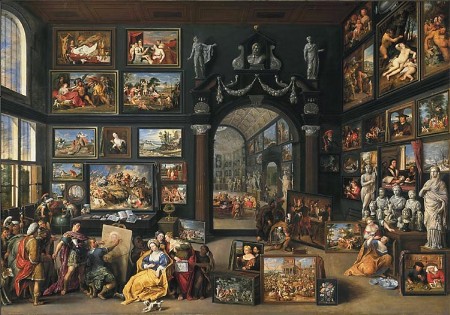
Guillam van Haecht, Alexander the Great at the studio of Apelles, while the artist is painting the portrait of Alexander's mistress Campaspe, ca. 1630. The Hague, Mauritshuis. Oil on panel, 102.5 x 137.5 cm.
By Gary Schwartz
Until June 27, a small exhibition of irresistible charm and interest is being held in the Mauritshuis in The Hague, after a run at the Rubenshuis in Antwerp: Willem van Haecht: room for art in 17th-century Antwerp. Van Haecht was one of the great masters of a kind of painting made only, from about 1610 to 1650, in Antwerp.
Called kunstkamer paintings, art-room paintings, they evoke images of real, imaginary, or hybrid art collections. The “rooms” vary from simple bourgeois interiors or even shelves to palatial spaces. Although the paintings are called kunstkamers, art never stands alone in them. It is associated with learning and worship and social relations. Rather than isolating art, these paintings show how deeply embedded it was in the life of the time.
Willem van Haecht (1593-1637) was an exceptional individual. (I prefer the form Guillam, the name under which he was inscribed in the Antwerp guild of St. Luke; he nearly always signed “G. V.Haecht”; in his last will, he is called Guilliam.)
He was the son and pupil of a landscape painter named Tobias Verhaecht (1561-1631), who was also the teacher of Peter Paul Rubens (1577-1640), to whom his first wife was related by marriage. His great-uncle Willem van Haecht (born ca. 1530) was a leading figure of the Lutheran Reformation in Antwerp, a poet, printmaker, and publisher of considerable importance. The Catholic Guillam was active as an art dealer in Paris and in Italy, but his main significance was as the confidant and collaborator of a wealthy Antwerp merchant, art collector, and protector of the arts named Cornelis van der Geest (1555-1638).
Living in van der Geest’s household as resident caretaker of his art collection, van Haecht worked on a number of projects related to his patron’s interests. Among these were campaigns to repair the physical damage to art perpetrated by iconoclasts. Van Haecht restored some damaged paintings in the Sint Gommaruskerk in Lier, to which van der Geest was attached.
Van der Geest and van Haecht also collaborated on the repair of the moral and spiritual damage to art that had been perpetrated by iconoclasts and Reformers. Both of them were officers of the Jesuit confraternity of unmarried men, a body that embraced art and imagery as an intrinsic part of divine worship. This is not mentioned in the catalog, nor do the authors seem interested in the Counter-Reformation messages built into van Haecht’s compositions.
Van der Geest had a particular love for the two Antwerp artists who to this day are considered the greatest artists of the sixteenth and seventeenth centuries respectively, Quinten Massys (1465-1530) and Peter Paul Rubens. On the hundredth anniversary of the death of Massys, van der Geest had the artist’s remains moved to the Cathedral to be reinterred in the outside wall, with an inscription commemorating this act of pious devotion to the Apelles of his age.
Van Haecht commemorated these themes in imaginative and endlessly fascinating kunstkamer paintings situated in the house of Cornelis van der Geest and the studio of Apelles. In the painting of the van der Geest collection (1628), van Haecht brings together various great moments in the life and love of the collector: the visit to his house of Archdukes Albert and Isabella in 1615, of the Polish king Sigismund III, his ownership of a Massys Madonna and child and Rubens’s Battle of the Amazons. In another kunstkamer, without a central narrative, we see men with the heads of asses destroying works of art in the background while the foreground is peopled by scientists, art-lovers, and students of the occult engaged in respectful study of art, a globe, and a manuscript.
Van Haecht was the subject of a dissertation that I began to write in 1965 and then abandoned after the new chairman of the department of art history at my university proclaimed, “I don’t believe in iconography” and discontinued my degree candidacy.
In the late 1980s and in the 1990s, I returned to van Haecht in lectures and in an article published in English in the Dutch art magazine Tableau (Summer 1996). When the news reached me several years ago that the Rubenshuis and Mauritshuis—the owners of his two most important paintings—were organizing an exhibition devoted to van Haecht, I let them know about my research into his work.
Here, I thought, was my chance to rid myself of one of the great frustrations of my scholarly life by participating in the preparations for the first van Haecht exhibition ever held. To my chagrin, the organizers ignored my offers and never even consulted me about the exhibition except when they needed contact information concerning potential lenders. When I confronted them with this, I was told that the exhibition was too small to allow for outside advisors. In this column, I will present some of the material that visitors to the exhibition, with its not-so-small 22 displays in three galleries and 144-page catalog, will be missing.
In the 1996 article, I wrote,
[The] reading of van Haecht as a repairer of the moral and material damage of iconoclasm and a proclaimer of Antwerp artistic hegemony by no means exhausts the meanings of his kunstkamer paintings. Van Haecht well deserved his epithet, in a print of 1630 by Guillaume Panneels dedicated to the honor of the “pictor artificiosissimi Antuerpiensis”: supremely sophisticated painter of Antwerp. Every student of his work comes up with different sets of significances in his overloaded compositions, of which the glorification of art and collecting are only the most obvious.
Sadly, the organizers of the exhibition display interest exclusively in the obvious art-world issues of patronage, collecting, display, and connoisseurship, to the exclusion of the social, political, and religious contexts that were of equal or greater importance to van der Geest and van Haecht. The exhibition pays only the merest lip service to the iconological worlds within the worlds that van Haecht conjures up. The images and captions below will give some idea of the riches on which the Rubenshuis and Mauritshuis have turned their backs.
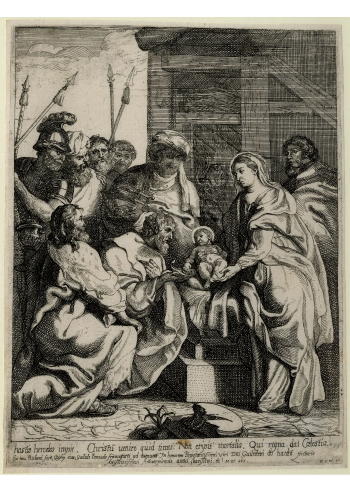
Guillaume (aka Willem) Panneels (b. ca. 1600; d. after 1630), The adoration of the Magi, etching after a painting by Peter Paul Rubens. London, British Museum
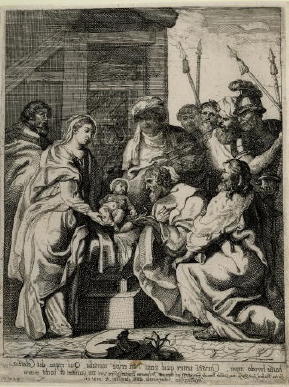
The same in reverse | Peter Paul Rubens, The adoration of the Magi, 1626 or 1627. Paris, Louvre
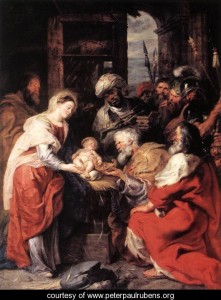
The adoration of the Magi
When Rubens spent a year-and-a-half abroad in 1628-30, he charged Panneels with the care of his drawings, kept in a locked cabinet that he called his cantoor, or office. When Rubens returned, Panneels left his service to go to Germany, armed with letters of recommendation by Rubens and Cornelis van der Geest alike. In Frankfurt, he etched the plate for this adaptation of Rubens’s Adoration of the Magi, now in the Louvre. It was ordered in 1626-27 by the widow of the chancellor of Brabant, Peter Pecquius, for the church of the Annunciation in Brussels.
The importance of the print for Guillam van Haecht lies in the inscribed dedication. The first line is a chorale for Twelfth Night (Epiphany), the celebration of the Adoration of the Magi, by the fifth-century church father Sedilius.
hostis herodes impie. Christū venire quid times: Non eripit mortalia. Qui regna dat Coelestia. (Herod, unholy host, what frightens you in the coming of Christ? He who brings the reign of heaven has no need of worldly goods.) The actual dedication reads:
Ex inu Rubeni fecit, Discip eius Guiliel.o Panneels francofurti ad moenum. In honorem Praestantissimi Viri Dni Guilielmi ab Haecht pictoris Artificiosiossimi Antuerpiensis amici Charissimi. etc. s.M DC XXX. F.V.W. ex. (Made after a composition by Rubens by his pupil Guillaume Panneels in Frankfurt am Main, in honor of the most excellent gentleman Mr. Guillam van Haecht, supremely sophisticated painter of Antwerp, dearest friend and more. 1630. Published by Franciscus van Wyngaerde.)
A dedication of such warmth, at such an important moment in the life of Panneels may be taken as evidence that he and van Haecht were true friends and that van Haecht therefore had privileged access to the Rubens studio.
The choice of subject matter for this important print—a tribute to his sponsors Rubens and, through his ward, to van der Geest—is very appropriate. The Adoration of the Magi is the iconography par excellence for demonstrating the acceptability of art in Christian worship. If Christ himself was willing to receive precious gifts, who are we to censure the practice?
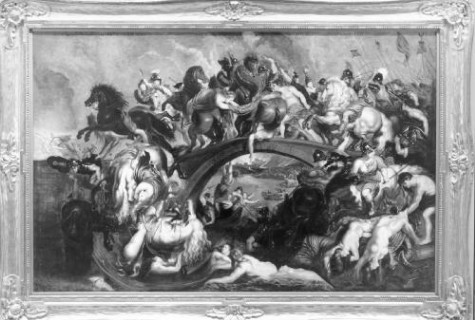
Not shown in the exhibition or illustrated in the catalog is a painting signed by van Haecht that has recently emerged in a private collection in the United States. It is a copy in reverse of Rubens’s Battle of the Amazons, one of Cornelis van der Geest’s proudest possessions.
At a meeting of the College Art Association in Chicago in February 2002, I was told about the painting by Gail Feigenbaum, then curator of European art at the New Orleans Museum of Art. The painting was on loan there from a private collector. When the plans for the current exhibition came to my attention, I offered to track the painting down if the costs could be built into the exhibition budget. It seemed to me that the opportunity to lend distinction to the exhibition by showing a completely unknown, new painting by the rare master, of a subject so central to his and van der Geest’s artistic concerns, would have been worth a bit of effort.
The organizers apparently did not agree, since I never heard from them about my proposal. (See p. 89, note 34, in the exhibition catalog for an obligatory reference.) The black-and-white image reproduced here is the first publication of the painting. (Since writing this, I have come into contact with the owner, who has kindly offered to provide new color images of the painting.)
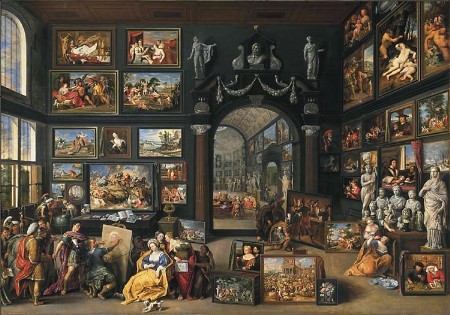
Guillam van Haecht, Alexander the Great at the studio of Apelles, while the artist is painting the portrait of Alexander's mistress Campaspe, ca. 1630. The Hague, Mauritshuis. Oil on panel, 102.5 x 137.5 cm.

Guillam van Haecht, Alexander the Great at the studio of Apelles, while the artist is painting the portrait of Alexander's mistress Campaspe, ca. 1630. Sale New York (Sotheby's), 28 January 2010. Oil on panel, 76 x 114 cm.
The final missing item in the exhibition is particularly painful. Until the year 2000, not four but five kunstkamer paintings were given to van Haecht. The fifth was a second version of the Studio of Apelles, signed G. V. H. in the lower right, of which the larger and more elaborate version is in the Mauritshuis. In all the printed literature on van Haecht and kunstkamer painting, van Haecht’s authorship of this panel is accepted. The organizers of the present exhibition do not consider it to be his work. Not only do they not display it, but, as far as I can see, they do not even mention its existence anywhere in the unindexed catalog.
This standoff had its start at The European Fine Arts Fair (TEFAF) in 2000. The London art dealer Simon Dickinson had bought the painting at the first auction to be held by Sotheby’s in France, on June 3, 1999 at the Château de Groussay, where the collection of Charles de Beistegui went under the hammer. When Dickinson brought the panel to the TEFAF the following year, he received a rude shock. One of the experts in the vetting committee for Old Master paintings was Frits Duparc, director of the Mauritshuis. Out of his intimate familiarity with the Studio of Apelles in his own museum, he was seized with the conviction that the second version was too weak to have been painted by van Haecht. The painting was withdrawn from the stand.
It reappeared at the fair in 2008, labeled as “Flemish school” or some such non-specific attribution. This was the only possibility if one rejected the authorship of van Haecht, since no other artist is known to have produced work in his style and his characteristic attributes. I had never doubted that a painting that so closely resembled the van Haecht Apelles in the Mauritshuis was by the same master, but I might have been wrong, and I was eager to see both paintings together. The art dealer was prepared to bring his version to The Hague to be compared with the Mauritshuis version. At the fair I proposed to Duparc’s new successor, Emilie Gordenker, that she accept the offer of the art dealer. She said that she thought it was a good idea.
However, the moment never came. I broached the subject once or twice thereafter, to no effect. Recently, Gordenker told me that she saw the painting in London and that she too thought it was not painted by van Haecht. Unable to find a buyer, Dickinson ended up selling it at the Sotheby’s Old Master sale on January 10, 2010 in New York. With an estimate of $200,000 to $300,000, the painting fetched $674,500 with buyer’s premium. Who the buyer is, is not public information. Another chance to compare it to the painting in the Mauritshuis may never arise.

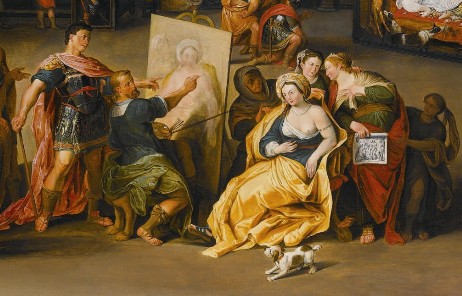
Details of the two versions of Alexander and Apelles, in the Mauritshuis (above) and the Sotheby's sale (below).
Whatever one thinks of the brushwork in the second Apelles, it is inconceivable to me that anyone interested in van Haecht would not leap at the opportunity to display it in a van Haecht exhibition, where it could be compared to the painting in the Mauritshuis. If it was not painted by van Haecht, it is nonetheless a first-class van Haecht object.
Perhaps it was painted in his studio by his only known pupil, Jan Panneels, the brother or cousin of his bosom friend Guillaume. Apparently the unpublished, unargued, negative opinion of a director of the Mauritshuis is enough to consign to total oblivion a work of art that has been published repeatedly by others. Oh connoisseurship, what hath thou wrought?
With regard to Guillam van Haecht’s prints and the second Apelles, I’m afraid that the organizers of the exhibition, despite the rest of their good work, have allowed themselves to be guided excessively by personal aesthetic preferences and the reputation of experts. This is all the more unfortunate since we are not likely to see another van Haecht exhibition in our time.
© Gary Schwartz 2010. Published on the Schwartzlist on June 12, 2010. (This is an edited version of the column—for the complete piece go here.)
=====================================================
The Dutch elections have taken a calamitous turn. Sixteen percent of the voters cast their ballots for the Party for Freedom (PVV) of the right-wing demagogue Geert Wilders. In my own estimate of European elections, I discount right-radical votes of up to 15 percent as an ineradicable but not necessarily dangerous expression of resentment. The extra percent that Wilders has garnered is threatening, but on the other hand he is no Jörg Haider; Wilders does not flirt yet with Nazism.
What is calamitous is the way he is being embraced by the Liberal Party and condoned by nearly all the rest. I do not approve of the extreme measure adopted by the Flemish centrist and left-wing parties, who maintain what they call a cordon sanitaire, a political boycott, around the right-wing Flemish Block. But that is no reason for Dutch politicians to lick up to Wilders and his voters as if they were expressing legitimate political opinions. The opinions proclaimed by Wilders are a deliberate provocation of the rule of law, and they should be treated as such. To conduct serious coalition negotiations with him, as are taking place this minute, is itself a threat to Dutch democracy.
==============================
Gary Schwartz was born in Brooklyn, New York in 1940. In 1965 he came to the Netherlands with a graduate fellowship in art history and stayed. He has been active as a translator, editor, and publisher; teacher, lecturer, and writer; and as the founder of CODART, an international network organization for curators of Dutch and Flemish art.
As an art historian, he is best known for his books on Rembrandt: Rembrandt: all the etchings in true size (1977), Rembrandt, his life, his paintings: a new biography (1984) and The Rembrandt Book (2006). His Internet column, now called the Schwartzlist, appeared every other week from September 1996 to April 2007 and has been appearing since then irregularly. His most recent book on Rembrandt is one of the six titles nominated for the Banister Fletcher Award for the most deserving book on art or architecture of that year.
In November 2009 Schwartz was awarded the coveted tri-annual Prize for the Humanities by the Prince Bernhard Cultural Foundation of Amsterdam.
Please address reactions to Gary.Schwartz@xs4all.nl
Tagged: 17th-century, Dutch, Gary-Schwartz, Painting, Schwartzlist, The Hague

Literature is my territory, not art, but looking at this stunning work, I’m immediately reminded of Brueghel: the joyful cramming in of as many images as possible, along with the joyful assumption that the viewer will be eager to examine every one!